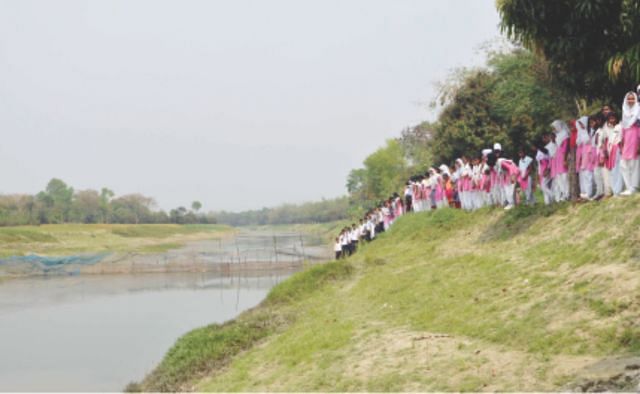Save Boral to save Chalan Beel
 Schoolchildren stand beside a nearly dead Boral River at Bon Kishore village in Charghat upazila of Rajshahi district, forming part of the 220-kilometre-long human chain from Charghat in Rajshahi to Baghabari in Sirajganj yesterday demanding steps for making the river regain its flow. Photo: Star
Schoolchildren stand beside a nearly dead Boral River at Bon Kishore village in Charghat upazila of Rajshahi district, forming part of the 220-kilometre-long human chain from Charghat in Rajshahi to Baghabari in Sirajganj yesterday demanding steps for making the river regain its flow. Photo: Star
Tens of thousands of people joined a 220-kilometre-long human chain along the Boral River in Rajshahi, Natore, Pabna and Sirajganj districts for an hour from 11:00am yesterday demanding steps to save Boral River that serves as lifeblood of the country's largest wetland Chalan Beel.
Bangladesh Poribesh Andolon (Bapa), Movement to Save Boral, Movement to Save Chalan Beel and Association for Land Reform Development jointly organised yesterday's programme, marking the International Day of Action for Rivers.
“We demand removal of all sluice gates and cross dams on the river and construction of a bridge across it, demarcation of the river area according to CS record, eviction of encroachers, ensuring navigability of the river by capital dredging to connect Padma, Jamuna and all other rivers of the region, and cancellation of unplanned fishing projects in the river,” said Dr Matin, secretary of Bapa.
The government has recently stopped leasing of the river for fishing projects but the other steps are yet to be taken, he said.
The Boral, originated from the Padma at Charghat in Rajshahi, flows into the Jamuna at Baghabari in Sirajganj district through the four districts and connects with 30 rivers in Chalan Beel area.
In the name of fishing projects, the then government in 1985 divided the Boral River with several cross dams and regulators and later three concrete roads were constructed across it.
Consequently, Chalan Beel turned into several detached stagnant water bodies.
"I have joined the human chain along with eight hundred students of my school demanding steps to save the river," Md Abdul Hamid, a teacher of St Louis High School at Zonail village of Gurudaspur upazila in Natore, told this correspondent during his visit to the area.
“I learnt about Boral from books but I am unfortunate to see the river dead in front of my house,” said Md Shamim Hossain, a class nine student of the school.
 A man, as a symbol of protest, gets his three kids smeared with mud from the drying river at Haripur village in the same upazila before participating in the human chain. Photo: Star
A man, as a symbol of protest, gets his three kids smeared with mud from the drying river at Haripur village in the same upazila before participating in the human chain. Photo: Star
Sobura Khatun, 80, along with his family members joined the human chain in front of her residence at Sondova village in Chatmohar upazila.
“My father and husband used to irrigate crop lands with water from the Boral River and caught fish there. But the river near our house now looks like a ditch without water. I feel like crying to see the pitiable sight,” said a lamenting Sobura.
During yesterday's programme, several meetings were held at different places including Charghat, Gurudaspur, Zonail, Chatmohar Zero Point, Bhangura Boral Station, Faridpur Bazar and Baghabari, said SM Mizanur Rahman, secretary of Movement to Save Boral.
Bapa Secretary Dr Abdul Matin accompanying columnist Abul Maksud and several environmentalists visited different spots of the programme.
Md Abdul Kuddus, lawmaker from Natore-4, Md Shahrial Alam, a lawmaker from Rajshahi-6, and Md Mokbul Hossain, lawmaker from Pabna-3 constituency, also joined the human chain and rallies in their areas.

 For all latest news, follow The Daily Star's Google News channel.
For all latest news, follow The Daily Star's Google News channel. 



Comments